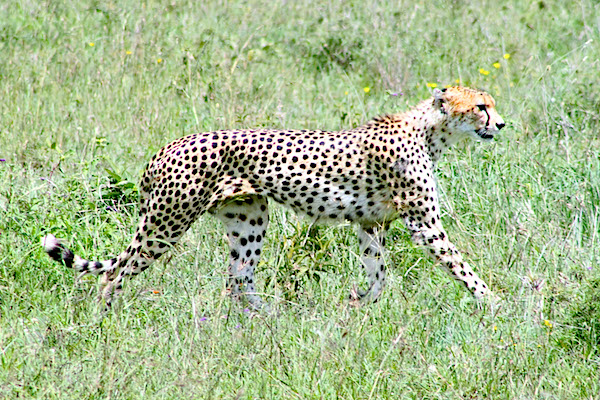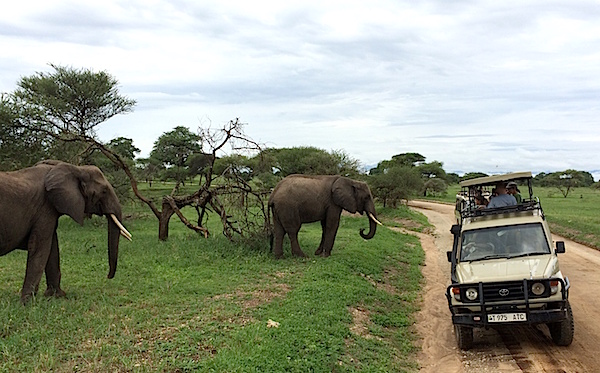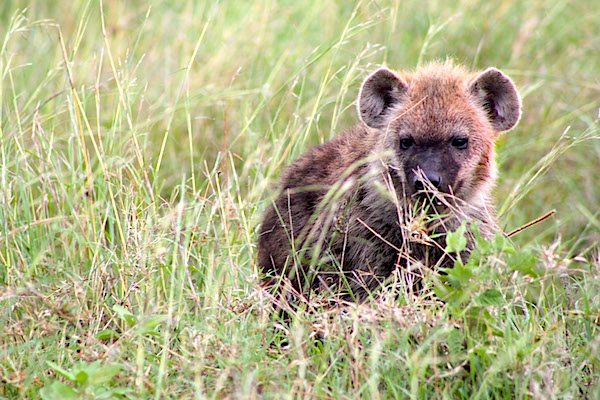 Safaris in national parks in Africa can lead to close encounters with wildlife, such as this cheeta/Sean Smith
Safaris in national parks in Africa can lead to close encounters with wildlife, such as this cheeta/Sean SmithEditor's note: Sean Smith is a former Yellowstone National Park ranger, and an award-winning conservationist, TEDx speaker, and author. He recently had the opportunity to visit some national parks in Tanzania, and returned home with thoughts of what the National Park Service might learn from its African colleagues.
I recently returned to the Northwest after a two-week Tanzanian safari. It was an amazing experience. The trip took us through Arusha, one of Tanzania’s larger cities, out to Tarangire and Serengeti national parks, and the Ngorongoro Conservation Area. The parks and conservation areas were filled with wildlife from the ubiquitous wildebeest to the rare black rhino.
African National Parks share many similarities with their American counterparts.
The parks are big. Serengeti, for example, is more than 3.7 million acres or roughly 1.5 times the size of Yellowstone. Put another way, Serengeti is larger than the state of Connecticut.
The parks are well-visited. Despite having to travel over many poorly maintained dirt roads, parks like the Serengeti and Ngorongoro see roughly 1 million tourists annually.
The parks protect natural and cultural resources. The Tanzanian Park Service, like its U.S. counterpart, protects both natural and cultural resources. Olduvai Gorge in the Ngorongoro Conservation Area protects one of the world’s most important historic sites and some of the oldest fossilized human remains. They like to say at Olduvai, if one traces his/her lineage back far enough, everyone is from Tanzania.
Yet, the Tanzania Park Service diverges from the U.S. National Park Service (NPS) on many issues. The African approach on several issues is an approach the NPS should copy.
Conservation over Recreation
The Tanzania Park Service places conservation and the protection of natural resources and wildlife over private recreation. Nearly every visitor to Tanzania’s national parks has a guide. These guides receive extensive training on resource and wildlife protection. The guides are taught to get the visitors deep into the parks for close-up but safe interactions with the wildlife. Private recreation such as hiking, mountain biking, and swimming is practically non-existent.
Yet, despite this focus on guided rather than private access, park visitors report high satisfaction with their safari adventures.

Elephants seemingly are habituated to humans and their vehicles/Sean Smith
Here in the United States, the NPS mistakenly promotes the idea that it has a dual mandate, one that requires the NPS to balance conservation with recreation. This is incorrect and the courts have consistently ruled that when there is a conflict between conservation and recreation, the law requires the Park Service to favor conservation. The Park Service’s continued pushing of the dual-mandate myth creates undue management headaches, as every recreation interest from snowmobiles to off-lease dog walkers demands access to the national parks. As a result, the national parks are compromised by questionable activities that in many instances do not require a national park setting to enjoy.
Africa takes conservation crimes seriously
Tanzanian park rangers and their African counterparts take environmental crimes seriously. During our safari, I asked our guide if the truck broke down, how would we contact the rangers for help? Our guide responded, “We wouldn’t. The rangers' job was to patrol the borders looking for poachers. We would have to get ourselves up and running again.”
This focus on poaching was recently rewarded when Tanzanian police arrested Feisal Muhammad Ali, the world’s most-wanted ivory trafficker. Meanwhile, rangers in South Africa shot and killed suspected rhino poachers. While I’m not advocating for the summary execution of park criminals, the U.S. government could do more to increase the understanding of the severity of environmental crimes. However, its handling of the Cliven Bundy standoff in Nevada and the courts' unwillingness to impose stiff penalties for poaching sends the message that resource crimes are no big deal.

Hyena in the grass/Sean Smith
Focus on experiences
Another area of focus for the Tanzania park rangers is a on visitor experience rather than amenities. To say the roads of Serengeti and Ngorongoro are rough is an understatement. In some instances, park roads are little more than a mud streak. Meanwhile, the Tanzanian national parks spend little on so-called necessities such as Wi-Fi and cellphone coverage. Interpretive displays are often rudimentary and lack any high-tech whiz bang features found in the United States. However, they provide information in multiple languages, increasing public understanding of why the parks are important.
Rather than providing distractions, the Tanzanian parks focus on preserving authentic experiences. An authentic experience is one that improves a visitor’s appreciation and understanding of park wildlife and natural features, while allowing low-impact intimate interaction with those resources. Unfortunately, many U.S. park activities significantly diminish authentic experiences.
America’s National Park Service will celebrate its 100th birthday in 2016. During the upcoming year, it’s expected the NPS will seek public comment on how best to ensure the park system and Service reach their bicentennial. The agency should look to Africa for guidance.
Sean Smith is a former Yellowstone Ranger, and an award winning conservationist, TEDx speaker, and author. He writes national park thrillers from his home in the shadow of Mount Rainier National Park. To learn more about his conservation work and novels, check out his blog: www.seandavidsmith.blogspot.com or follow him on twitter: @parkthrillers

 Support Essential Coverage of Essential Places
Support Essential Coverage of Essential Places







Comments
Gary, one new road comes to mind immediately. The bypass road around Gibbon Falls in Yellowstone. I'm sure there are more. That one features a very high bridge to carry it from one side of canyon across to the other. I have not been down to the falls lately, but fear that bridge might be somewhere above the falls. Does anyone here know?
Dr. Runte is right on when he talks about capacity, overcrowding and trying to accomodate it all. One current example is the expansion of the VC parking lot in Zion to hold more than a hundred additional cars.
But again, I'm forced to ask if anyone out here can come up with a really workable solution other than closing the gate when X number of vehicles have entered the park each morning.
I had forgotten about the Gibbon Falls bypass, but I don't believe it can be seen from the falls. I walked parts of the alignment right after it had been cleared, but conceded, as Superintendent Mike Finley asked, that there was "not much else" he could do.
Sometime this century, I do believe we will follow the Europeans and substitute many of these roads for light rail. By then, the absurdity of insisting we must curb global warming while maintaining an auto culture will have hit us. Yellowstone and Yosemite will "go back to the future," so to speak, just as Glacier National Park, will its glorious red buses and TRAIN, never abandoned that future. Both, especially the red buses, are the "pace cars" of a slower pace of life. Have you ever noticed how people slow down in the presence of those historical "relics?" But then, why should we be surprised? The red buses are fun; they are beautiful to look at; their interiors are intimate and they MEET THE TRAIN. You don't "need" a car in Glacier. You really don't. That simply needs to be true of all our parks.
In America, we think of the past as "nostalgia." In Europe (and Africa), the past is something to respect. When I wrote the first edition of my TRAINS OF DISCOVERY, I wondered aloud how we ever confused "progress" for respect. The point is that Glacier National Park was not confused. At least, forces conspired to keep it respectful of the past. Amtrak kept the EMPIRE BUILDER; the concessionaire kept the red buses, until eventually they were restored.
So, all is not lost. We have the "model." We just need to apply it with greater conviction. You're parking the BIG BUS at the gate; the BIG MOBILE HOME at the gate; the BIG SUV at the gate. Inside, expect the roads to twist and turn. You will see wildlife; you will see all of this park. You will just have to check your "individualism" at the gate. But that's all we are asking you to forfeit. We indeed want you to enjoy your park.
As I said, I do believe we will get there, because that is how it all began. It just takes time, for as Winston Churchill said, we Americans are in the habit of trying everything else before trying what we knew we needed in the first place.
I agree entirely, Alfred. But it's going to require an almost complete overhaul of the American way. Just witness what's happening right now. After several years of gas prices between $3 and $4, people were starting to buy smaller fuel efficient vehicles. But now, gas prices have dropped and stayed down for nearly Three Whole Months! Guess what? Sales of large SUVs and other guzzlers are going up and up and up.
Churchill was absolutely correct.
So was Mike Finley. Almost always the mess we've created in the past will continue to dictate how the future will be handled.
Your agenda exposed. If you don't like the "American way" why don't you move elsewhere?
So what?
Thank you Owen, I remember some of those discussions well, in fact at the time plans were already being formulated to increase the size of the Ahwahnee Hotel, build a tramway from Curry Village to Glacier Point, etc., well it was interesting. By 1974, things were well advanced in the planning stages, a new company had replaced YP&C, Roger CB Morton the DOI secretary, appointed by President Nixon, was in support. A young sanitation worker for the NPS, a gentleman by the name of Joe Boland (still a neighbor here in Mariposa County), blew the whistle so to speak, he had connections and Jack Anderson started running columns on the controversy. That did it, a new Superintendent was appointed and the result was the General Management Plan of 1980 which by the way also had a visitor capacity number. It is interesting to note that here it is almost 40 years later, and we are still at the discussion stage of visitor capacities., through the Parks approved Merced River Plan has a visitor capacity number also. A complex issue.
Before we all move some place else, as ec suggests, maybe we ought to think of a couple different ways to control crowding, thus getting at the carrying capacity question, in some of our more popular parks, How about a reservation system? If you get to Yellowstone on, say, July 15th, and you don't have a reservation, you don't get in. Before everyone throws up his or her hands at the thought, we do this all the time. If I want to go to a concert and the venue is sold out, I don't go there expecting to get in.
How about an NPS exam? I heard this idea first from a professor at UC Santa Barbara. Dr. Runte will know of whom I speak. If I want to go to Grand Canyon, to qualify for my entrance pass, I have to successfully complete a short exam on the geology of the Canyon. It shows that I have prepared for my visit. This is another thing we are used to. To go to a university, one has to achieve acceptable scores on whatever test is being administered at that time. If I want to drive a car, I have to pass a test showing that I know the traffic laws of the state in which I reside.
Difficult to administer? Yes, but not all that much more difficult than what hotels and restaurants do with reservations or what a state with a large population such as NY does with drivers licenses.
And remember, these ideas would only apply to a few park areas in the System where carrying capacity or overcrowding is an issue.
Rick
I have been on light duty with a pulled muscle, so have had the time to read all the comments on this topic. Very interesting, thank you Traveler. I think R. Smith has a good point, there maybe areas where a day use reservation makes sense, it can be done, and it can be quite equitable. Some systems allow for holding back a % of the quota for first come, first serve, some also allow for one vehicle out, one vehicle in. I remember a trip to Mammoth Cave, as I entered one of the gateway communities, there were sings stating all cave walks full for the day. I wanted to do one, and the local motels/campgrounds advertised "stay with us, we can make a reservation for you". That is what I decided to do, it worked out just great, but required me to be a little more flexible in my travel plans. Visitor capacities are a contentious issue, and as some have pointed out, access by the visitor to the parks is a valid concern. I know managers are reluctant to implement these systems, no one wants to tell our fellow citizens the park is full, and I think that is an appropriate concern. But at some point, we either have to build more infrastructure, or ask people to give a little on the issue. A very interesting listserve discussion.
Ron--I would be hesitant to build more infrastructure in those parks where carrying capacity is already an issue. Most of them have too much infrastructure currently as Drs. Runte and Hoffman have pointed out. I would much rather try to enhance the visitor's experience by limiting the number visitors or spreading them out. Another possibility is a public transportation system such as the one employed in Zion. I remember the bad old days when 10,000 cars, it seems, circled around Zion Canyon looking for 5,000 parking spots. The Canyon now seems much less crowded and frantic with no private vehicles than it did pre-tram days.
Rick